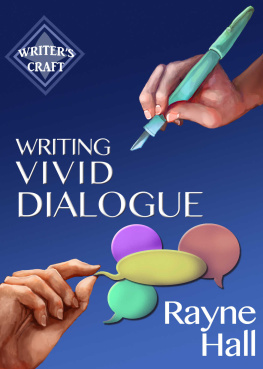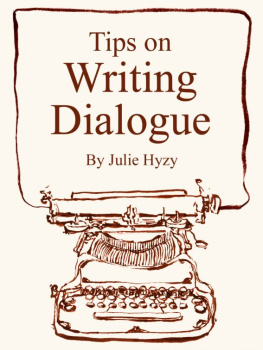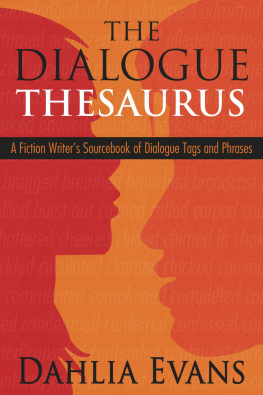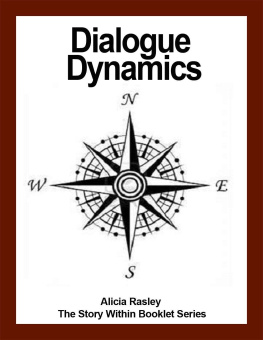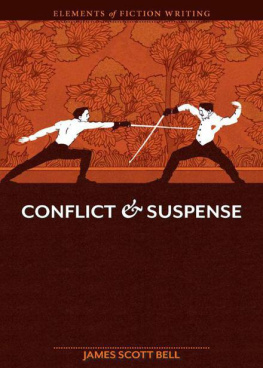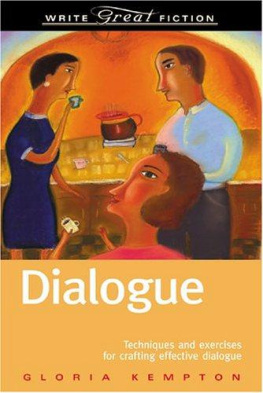WRITING VIVID DIALOGUE
Copyright Rayne Hall 2015
(December 2015 Edition)
All Rights Reserved
Cover art and design by Erica Syverson
Interior illustrations by Hanna-Riikka
WRITING VIVID DIALOGUE
Rayne Hall
Table of contents
INTRODUCTION
Do you want to write fast-paced, exciting, sizzling dialogue?
This book reveals professional dialogue technique to characterise the speaker, carry the plot forward and entertain your readers.
This is not a beginner's guide. I assume that you have mastered the basics of fiction writing, and don't need an explanation of what dialogue is and why it matters for your story. But your dialogue isn't yet as strong as your story deserves. Perhaps it drags, perhaps the characters all sound the same, and perhaps it lacks tension, wit or sparkle.
I'll offer you a toolbox filled with techniques. These are not 'rules' every writer must follow, but tricks you can try. Pick, mix and match them to suit your characters and your story.
Some of these tools work for all kinds of dialogue, others solve specific problemshow to create male and female voices, how to present foreign languages and accents, how to present historical dialogue and flirtatious banter, how to write dialogue for alpha characters, for children and for liars.
I suggest you read once through the whole book to discover the tools in this kit, then return to the specific chapters which address the challenges of your current project.
You can apply the techniques to write new dialogue scenes, or to revise sections you've already written. When revising, you may want to compare the 'before' and 'after' versions. You'll be amazed how your dialogue scenes come to life.
I won't weigh this book down with literary theory. Sometimes I'll use examplesmostly from my own books, for copyright reasonsbut in essence, this is about your writing, your stories, your dialogue.
If you like you can use this book as an advanced dialogue writing course, working your way through each chapter, doing the exercises in the chapter and the assignments at the end of each chapter. Or you can simply read the whole book to get a feel for what's in it, then choose the techniques you want to study and apply for the chapter you want to write or revise.
When referring to readers and characters, I'll sometimes use 'she' and sometimes 'he', simply to avoid the clunky 'he or she' constructions. The only time when gender matters in this book is when I compare female and male speech patterns, for example in Chapter 11. I'm using British English. If you're used to American, some of my word choices may look unfamiliar, and the syntax, grammar, punctuation and spelling varies as well, but the principles are the same.
Now open your manuscript. Let's improve your dialogue.
Rayne
1 A QUICK FIX TO ADD INSTANT INTEREST: ASK QUESTIONS
Have you written a dialogue scene that's basically okay, but needs to be more interesting?
I have a quick technique to enhance it without major changes. Questions rouse the reader's interest, so simply turn some statements into questions.
Here are some statements, and how you might phrase them as questions instead. You can see how much more intriguing the questions are.
I want Santa to bring me a doll.
Will Santa bring me a doll?
I'm looking for my wallet.
Have you seen my wallet?
You haven't gone to church for a long time.
When was the last time you went to church?
The dam may not hold much longer.
How much longer will the dam hold?
You never seem to listen to what I say.
Do you ever listen to what I say?
Maybe there really is a monster in the lake.
What if there really is a monster in the lake?
Suddenly, the speaker's words have undercurrents which add depth and engage the reader. If you like, you can apply this technique liberally, and pepper your dialogue scene with questions. Keep only a few statements so the rhythm doesn't get monotonous.
In the next chapter, I'll show you how to escalate this method to create tension.
ASSIGNMENT
Take a dialogue scene you've drafted and are not entirely happy with. Change several statements to questions. Enjoy the 'before-and-after' transformation.
2 BUILD TENSION BY WITHHOLDING ANSWERS
In this chapter, I'll show you an effective technique for making your dialogue simmer with tension.
One character (let's call her Mary) asks a question, and the other (John) doesn't answer. Now the reader definitely wants to know the answer, and also why John withholds it.
Perhaps Mary repeats the question. Does John answer now, or use a different avoidance tactic? With each unanswered question, the tension mounts. Why does John not reply? What does he have to hide? Why does Mary insist on drawing the information out of him? What does she suspect? Why does he resist? Which of the two will prevail?
Here are several ways you can handle this:
* Mary asks a question. John busies himself with some activity before replying. The reader senses that John needs time to compose his answer. Does he have to sort out his thoughts first, or perhaps he needs to compose himself and gather his courage, or maybe he is inventing a lie?
* Mary asks a question. John replies, but he doesn't answer the actual question. The reader senses that John has an unpalatable truth to hide but doesn't want to tell a lie. What John says may or may not hold a hint of what the problem is. Perhaps he's preparing the ground for a painful truth to be revealed later.
Here's an example, provided by author Alice Gaines:
Daddy, will Santa bring me a bicycle this year?"
You know, honey, Santa cant always bring you exactly what you want. He has a lot of children to take care of, and sometimes he gets the orders mixed up.
* Mary asks a question. John gives a perfunctory reply or no reply at all, and changes the subject. The reader knows that Mary has touched a sore spot and that John has a reason not to tell the truth.
* Mary asks a question. Instead of answering, John asks a question. This is my favourite technique because it hints at defensiveness and secrets. If you like, you can have the characters ping-pong questions at each other, escalating the tension with each exchange.
Here are two examples:
Example 1: Wife and Husband
W: Do you still love me?
H: Why are you asking?
W: Do you still truly love me?
H: Are you suddenly doubting my love?
W: Why won t you tell me that you still love me?
H: Do we have to talk about this now?
W: Why aren t you answering my question?
H: What do you want me to say?
Example 2: Police Officer and Suspect
P: Where were you between ten and eleven last night?
S: Why do you want to know?
P: Where were you between ten and eleven last night?
S: Where should I have been?
P: Why don t you tell me where you were?
S: Are you accusing me of something?
P: Do you have something to hide?
S: What makes you think I have something to hide?
* Mary asks a question. John answers it eventually, but several chapters later. By now the reader senses a big secret, especially if Mary keeps probing and gets nowhere. When the answer finally comes, the truth may be as shocking for the reader as it is for Mary.
SAMPLE DIALOGUE SCENE FROM STORM DANCER
This scene shows how I used answer avoidance (with many questions answered with questions) in one of my novels, Storm Dancer .
Background: Dahoud is a former siege commander who once ordered and committed atrocities. Leaving his dark past behind, he has assumed a new identity as a peace-loving, benevolent ruler. Nobody knows that he is the monster who ravaged the land. If his secret is found out, Dahoud's life will be forfeit and the country will erupt in war.
Next page
